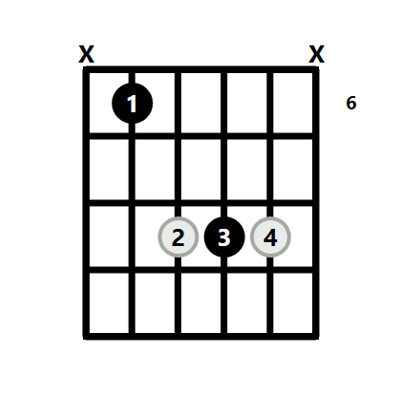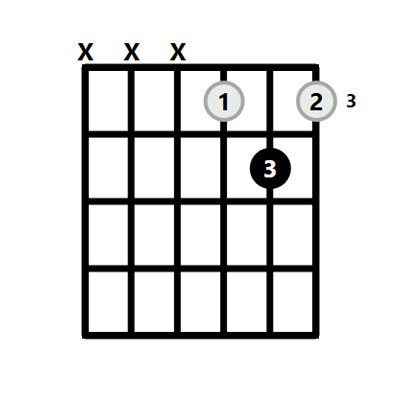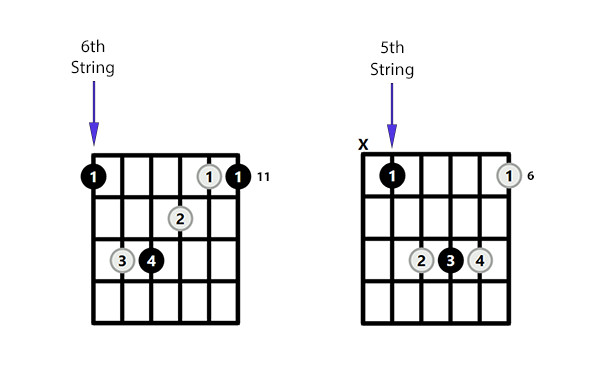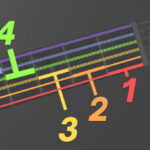The Eb Major guitar chord is a foundational chord for guitarists across genres. Known for its rich and warm sound, it’s a staple in countless songs and a crucial stepping stone in your guitar journey. Whether you’re just starting or looking to deepen your understanding, this guide will provide you with everything you need to master the Eb Major chord.
Unpacking the Eb Major Chord: Theory and Construction
Before diving into shapes, let’s understand what makes up the Eb Major chord. Like all major chords, the Eb Major is built on a triad – three notes played together. These notes are derived from the E Flat Major scale:
- Eb (Root): The foundation of the chord, giving it its name.
- G (Major Third): This note provides the major quality, contributing to the chord’s bright and happy sound.
- Bb (Perfect Fifth): The fifth note of the scale, adding stability and completeness to the chord.
These three notes – Eb, G, and Bb – are the essential ingredients of the Eb Major chord. Understanding this simple construction will help you recognize and apply the chord in various musical contexts.
The Eb Major chord, in terms of intervals from its root note, consists of:
- Major Third: The interval between Eb and G.
- Minor Third: The interval between G and Bb.
- Perfect Fourth: The interval from Bb back to Eb (an octave higher).
Furthermore, the Eb Major chord holds a significant position in music theory as the tonic (I) chord in the key of Eb Major. This means it’s the home chord, the central point of harmonic resolution in this key. The complete set of chords in the key of Eb Major are:
- Eb Major (I)
- F minor (ii)
- G minor (iii)
- Ab Major (IV)
- Bb Major (V)
- C minor (vi)
- D diminished (vii°)
10 Essential Ways to Play the Eb Major Chord on Guitar
Now, let’s get practical and explore ten different shapes for playing the Eb Major chord on your guitar. Visualizing these shapes will greatly expand your chord vocabulary and versatility.
 Diagram showing 10 shapes for Eb Major Chord on guitar
Diagram showing 10 shapes for Eb Major Chord on guitar
The Standard Eb Major Chord Shape: The Root 5 Barre Chord
The most widely recognized Eb Major chord shape is a barre chord based on the ‘root-5’ barre chord form. Typically played at the 6th fret, this shape provides a full and resonant sound. Often, guitarists will barre across the strings with their first finger, but sometimes, as shown below, the index finger only frets the root note on the 6th string.
 Diagram of the standard Eb Major chord shape on a guitar fretboard
Diagram of the standard Eb Major chord shape on a guitar fretboard
The Easy Eb Major Chord Shape: Perfect for Beginners
If barre chords are still a challenge, the “easy” Eb Major chord shape is an excellent starting point. This simplified version focuses on the top three strings, making it much easier to fret. It’s essentially the same shape as an open D Major chord, but moved up one fret. This shape is ideal for beginners to start incorporating the Eb Major sound into their playing.
 Diagram of the easy Eb Major chord shape on a guitar fretboard
Diagram of the easy Eb Major chord shape on a guitar fretboard
Step-by-Step Guide to Playing the Standard Eb Major Chord
For those who prefer step-by-step instructions, here’s how to form the standard Eb Major chord shape:
- First Finger: Place your first finger on the 6th fret of the 5th string.
- Second Finger: Place your second finger on the 8th fret of the 4th string.
- Third Finger: Place your third finger on the 8th fret of the 3rd string.
- Fourth Finger: Place your fourth finger on the 8th fret of the 2nd string.
- Strumming: Avoid strumming the 6th string and strum downwards across the top five strings.
Following these steps meticulously can be incredibly helpful, especially when learning new chord shapes. By breaking down the chord into individual finger placements, you can ensure accuracy and develop proper technique.
Eb Major Barre Chords: Root 6 and Root 5 Variations
As you progress, mastering barre chords will unlock further possibilities for playing the Eb Major chord across the fretboard. You can play Eb Major as a barre chord using two primary shapes:
- Root 6 Barre Chord Shape: Based on the E Major shape, barre at the 11th fret.
- Root 5 Barre Chord Shape: Based on the A Major shape, barre at the 6th fret (as seen in the standard shape).
These barre chord variations provide tonal variety and allow for smooth transitions between chords in different positions on the neck.
 Diagram showing Eb Major barre chord shapes on guitar fretboard
Diagram showing Eb Major barre chord shapes on guitar fretboard
Exploring Eb Major Triads and Inversions
Beyond full chord shapes, understanding triads – three-note chords – and their inversions adds another layer of sophistication to your playing. Eb Major triads can be voiced in three inversions:
- Root Position: Eb – G – Bb (Root note is the lowest)
- 1st Inversion: G – Bb – Eb (Third is the lowest)
- 2nd Inversion: Bb – Eb – G (Fifth is the lowest)
Here are several ways to play Eb Major triads and their inversions across the guitar neck. Experimenting with these voicings can enhance your chord melodies and arrangements.
 Diagram of Eb Major triad shapes and inversions on a guitar fretboard
Diagram of Eb Major triad shapes and inversions on a guitar fretboard
Eb Major Chord in Different Musical Keys
The Eb Major chord naturally appears in several musical keys. Recognizing these key relationships will help you understand chord progressions and songwriting. You’ll find the Eb Major chord as a diatonic chord in:
- Eb Major: As the tonic (I) chord.
- Bb Major: As the IV chord.
- Ab Major: As the V chord.
- C minor: As the III chord.
- G minor: As the VI chord.
- F minor: As the VII chord.
(Note: Links to related chords like Fm, Gm, Ab, Bb, Cm, Ddim, Dm, F, Adim, Bbm, Db, Gdim are intentionally kept as in the original article, though not explicitly requested to be recreated here)
Alternative and Useful Eb Major Chord Shapes
While the standard and barre chord shapes are most common, exploring alternative voicings can add unique textures to your playing. These shapes might not be as frequently used, but they offer interesting sonic options and can be useful in specific musical contexts.
Eb Major Chord Substitutions
The Eb Major chord is harmonically versatile and can be substituted with related chords to create variations and color in your music. Common substitutions include:
- Eb sus4 Chord
- Eb sus2 Chord
- Eb add9 Chord
Conversely, in certain situations, the Eb Major chord itself can act as a simplification for more complex chords that share Eb as their root, such as:
- Eb Major 7 Chord
- Eb7 Chord
- Other Eb-based extended chords (though it cannot replace minor chords).
Scales to Play Over the Eb Major Chord
For improvisation and melody creation over the Eb Major chord, certain scales are particularly effective. These scales harmonize well with the major tonality and provide a strong foundation for soloing:
- Eb Major Scale: The most natural choice, outlining the chord tones perfectly.
- Eb Major Pentatonic Scale: A simpler, five-note scale that works well for blues and rock-influenced solos.
- Eb Lydian Mode: Offers a brighter, more exotic sound with its raised 4th degree.
Further Exploration
To deepen your chord knowledge and guitar skills, consider exploring resources like “Guitar Chords Galore eBook” for a comprehensive collection of chords and lessons.
 Image promoting Guitar Chords Galore eBook
Image promoting Guitar Chords Galore eBook
Explore “Guitar Chords Galore eBook” for a deeper dive into guitar chords and techniques.
By mastering the Eb Major guitar chord and understanding its theory, shapes, and applications, you’ll significantly enhance your guitar playing and musical understanding. Keep practicing and experimenting with these different shapes and concepts to unlock the full potential of this essential chord!

